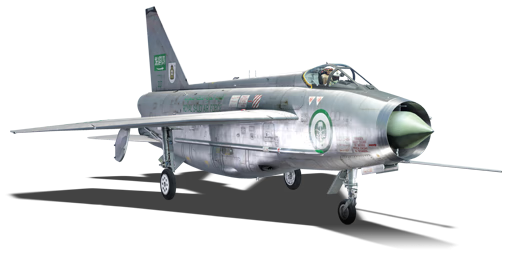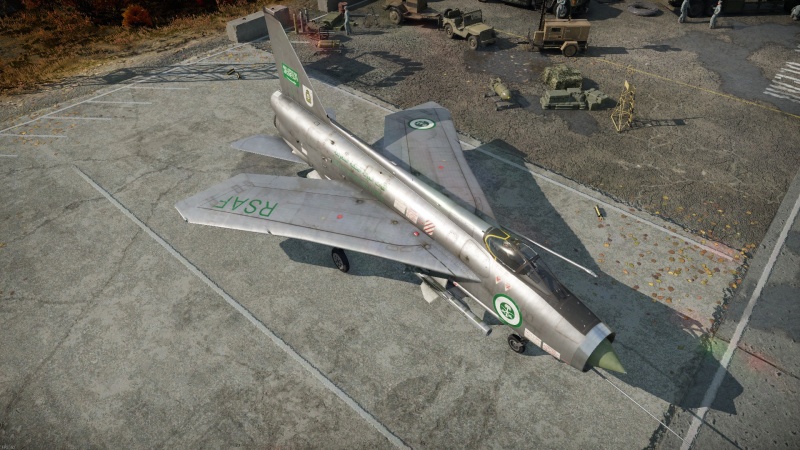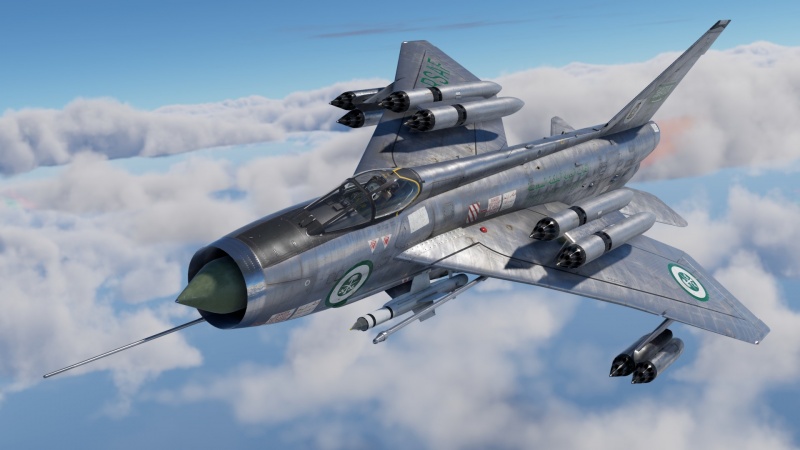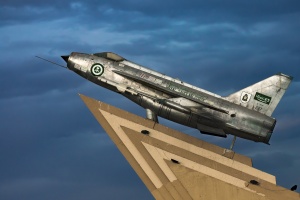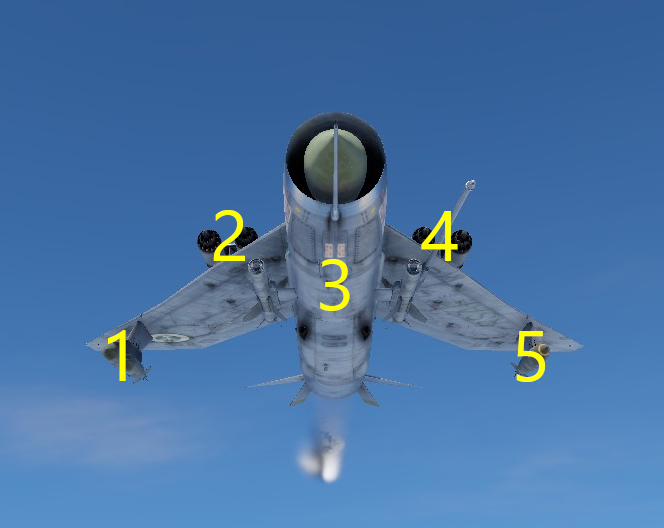Lightning F.53
| This page is about the premium gift British jet fighter Lightning F.53. For the regular version, see Lightning F.6. |
Contents
Description
During the late 60s, when the Lightning was no longer considered "Cutting edge" and the RAF was in the process of acquiring F-4 Phantoms, the MoD greenlit the export of the Lightning to close Middle Eastern allies, namely Kuwait and Saudi Arabia. The export variants were divided into two types, the Lightning F.52 being ex-RAF Lightning F.6 converted for export, and F.53 being newly built specialized ground-attack export models of the F.6, with more hardpoints for bombs or unguided rocket pods, with a total of total of 46 built, 12 F.53Ks for the Kuwaiti Air Force and 34 F.53s for the Royal Saudi Arabian Air Force, with one aircraft crashing during shakedown tests before delivery, resulting in a hasty replacement F.53 being rebuilt from an old F.6 airframe to meet the delivery time. Saudi Arabia recieved their first F.53 in 1967, and would extensively use them until 1986 when the Saudis starting trying to acquire the Tornado IDS to replace it, which they successfuly completed in 1989 with the first Tornado IDS deliveries in that same year.
The Lightning F.53 is a premium gift rank VI British jet fighter
with a battle rating of 9.3 (AB/RB) and 9.7 (SB). It was introduced in Update "Danger Zone" as a premium pack but was removed from the Gaijin store after the 2022 "Winter sale". It was briefly made available for purchase with Golden Eagles ![]() for the 2023 anniversary of its first flight. The aircraft is a more ground-attack oriented version of the Lightning F.6 in the tech tree, and as such, is slightly heavier, meaning the already mediocre air-to-air performance at that BR of the Lightning is now slightly worse. The F.53 shines in frontline high speed ground attack runs thanks to its insanely large amount of unguided rockets (up to 192x) across underwing pods, overwing pods, and an internal rocket bay. The F.53 is indeed a unique and peculiar aircraft which does not particularly excel at many things, and acts best as a collector aircraft for people interested in the rich history of Middle Eastern military aviation.
for the 2023 anniversary of its first flight. The aircraft is a more ground-attack oriented version of the Lightning F.6 in the tech tree, and as such, is slightly heavier, meaning the already mediocre air-to-air performance at that BR of the Lightning is now slightly worse. The F.53 shines in frontline high speed ground attack runs thanks to its insanely large amount of unguided rockets (up to 192x) across underwing pods, overwing pods, and an internal rocket bay. The F.53 is indeed a unique and peculiar aircraft which does not particularly excel at many things, and acts best as a collector aircraft for people interested in the rich history of Middle Eastern military aviation.
General info
Flight performance
| Characteristics | Max Speed (km/h at 12,192 m) |
Max altitude (metres) |
Turn time (seconds) |
Rate of climb (metres/second) |
Take-off run (metres) | |||
|---|---|---|---|---|---|---|---|---|
| AB | RB | AB | RB | AB | RB | |||
| Stock | 2,240 | 2,213 | 18288 | 22.8 | 28.0 | 124.6 | 115.4 | 850 |
| Upgraded | 2,353 | 2,290 | 24.4 | 26.0 | 177.8 | 150.0 | ||
Details
| Features | |||||
|---|---|---|---|---|---|
| Combat flaps | Take-off flaps | Landing flaps | Air brakes | Arrestor gear | Drogue chute |
| X | ✓ | ✓ | ✓ | ✓ | ✓ |
| Limits | ||||||
|---|---|---|---|---|---|---|
| Wings (km/h) | Gear (km/h) | Flaps (km/h) | Max Static G | |||
| Combat | Take-off | Landing | + | - | ||
| 1361 | 463 | N/A | 654 | 463 | ~10 | ~6 |
| Optimal velocities (km/h) | |||
|---|---|---|---|
| Ailerons | Rudder | Elevators | Radiator |
| < 850 | < 700 | < 700 | N/A |
Engine performance
| Engine | Aircraft mass | |||||
|---|---|---|---|---|---|---|
| Engine name | Number | Basic mass | Wing loading (full fuel) | |||
| Rolls-Royce Avon Mk.302 | 2 | 14,020 kg | 436 kg/m2 | |||
| Engine characteristics | Mass with fuel (no weapons load) | Max Takeoff Weight | ||||
| Weight (each) | Type | 6m fuel | 20m fuel | 22m fuel | ||
| 1,310 kg | Afterburning axial-flow turbojet | 15,382 kg | 18,109 kg | 18,559 kg | 19,000 kg | |
| Maximum engine thrust @ 0 m (RB/SB) | Thrust to weight ratio @ 0 m (WEP) | |||||
| Condition | 100% | WEP | 6m fuel | 20m fuel | 22m fuel | MTOW |
| Stationary | 5,616 kgf | 7,413 kgf | 0.96 | 0.82 | 0.80 | 0.78 |
| Optimal | 5,616 kgf (0 km/h) |
7,747 kgf (1,000 km/h) |
1.01 | 0.86 | 0.83 | 0.82 |
Survivability and armour
The Lightning F.53 has an identical internal layout to the Lightning F.6 upon which it is based. This means that most of the area in the wings is full of fuel tanks; likewise the stacked and staggered engines are retained. While the top engine is exposed and vulnerable to enemy attacks it can often absorb bullets, protecting the lower engine from damage (assuming the enemy is attacking you from the rear and above).
Where the Lightning F.53 does differ from the Lightning F.6 is in the addition of a 64 mm bulletproof glass windscreen. This is the only armour found on either aircraft.
Modifications and economy
Armaments
Offensive armament
The Lightning F.53 is armed with:
- 2 x 30 mm ADEN cannons, belly-mounted (120 rpg = 240 total)
Suspended armament
The Lightning F.53 can be outfitted with the following ordnance presets:
- Without load
- 2 x Firestreak missiles
- 2 x Red Top missiles
- 4 x 540 lb Mk.M2 bombs (2,160 lb total)
- 2 x 1,000 lb L.D H.E. M.C. Mk.1 bombs (2,000 lb total)
- 144 x SNEB type 23 rockets + 48 x RN rockets
- 144 x SNEB type 23 rockets + 2 x Firestreak missiles
- 2 x Firestreak missiles + 4 x 540 lb Mk.M2 bombs (2,160 lb total)
- 2 x Red Top missiles + 144 x SNEB type 23 rockets
- 2 x Red Top missiles + 4 x 540 lb Mk.M2 bombs (2,160 lb total)
Custom loadout options
| 1 | 2 | 3 | 4 | 5 | ||
|---|---|---|---|---|---|---|
| 540 lb Mk.M2 bombs | 1, 2 | 1, 2 | ||||
| 1,000 lb L.D H.E. M.C. Mk.1 bombs | 1 | 1 | ||||
| RN rockets | 48 | |||||
| SNEB type 23 rockets | 18, 36 | 36 | 36 | 18, 36 | ||
| Firestreak missiles | 2 | |||||
| Red Top missiles | 2 | |||||
| Maximum permissible weight imbalance: 450 kg | ||||||
Usage in battles
The Lightning F.53 is not unique for its battle-rating, if you've played the F-104, you may find it very similar. However, the Lightning F.53 gets load-outs for ground targets that should not be ignored. It can carry enough payload to destroy entire convoys or bases while still carrying its two anti-air missiles. The bombs might feel compromising as they can only be dropped when flying under Mach 1, while the Lightning F.53 benefits from going over Mach 1 and generally just naturally reaches speeds above that; If you wish not to sacrifice speed, a loadout can be used of the two air-to-air missiles and rocket pods for the rest of the hardpoints, the 144 SNEB rockets are enough to take out one base (but at Mach speed, the rockets are suboptimal for attacking convoys).
When it comes to engaging air targets, a boom-and-zoom approach is most suited, the Lightning F.53 can turn quite well when flying just under Mach, however, it is much easier for the Lightning to outrun missiles than to try out-turning them. The 2 Red Top missiles are capable but must be used with care, their range is very limited at the speeds the Lightning F.53 tends to face, at the BR's top speeds, their effective launch range is within 2.5km from the sides and 1.5km from the rear. Targets should be carefully considered as well, many aircraft at the BR have flares, one of the main distinctions that need to be made is between the F-104A and F-104C, both at the same BR, the A does not get flares while the C does. Another recurring aircraft is the A-10A, while it is an optimal target for the Lightning F.53's guns as it is slow and will have trouble manoeuvring out of the line of fire, caution must still be in order as it possesses extremely potent all-aspect missiles. The Su-25 should be handled with the same amount of caution, the Lightning F.53 generally cannot outmanoeuver those missiles.
The Lightning F.53 comes with a radar, locking on with the radar may seem pointless as it does not possess radar-guided missiles, however, the radar lock facilitates the missile lock even if it is not outright guiding them, so it is a good habit to radar-lock air targets you are be going after.
Pros and cons
Pros:
- Good climb rate and acceleration.
- Formidable angle-of-attack above low speeds.
- Very powerful cannons, and good missiles.
- Surprisingly good turn rate between 800 and 1,000 km/h IAS.
- Large rocket payload.
Cons:
- Quite poor energy retention.
- Large target for enemy aircraft.
- Awkward under-belly cannon placement.
- Relatively low top speed (1,280 km/h IAS at sea level).
- Poor low-speed manoeuvrability - accurate low-speed usage of rockets against ground targets is difficult.
History
Describe the history of the creation and combat usage of the aircraft in more detail than in the introduction. If the historical reference turns out to be too long, take it to a separate article, taking a link to the article about the vehicle and adding a block "/History" (example: https://wiki.warthunder.com/(Vehicle-name)/History) and add a link to it here using the main template. Be sure to reference text and sources by using <ref></ref>, as well as adding them at the end of the article with <references />. This section may also include the vehicle's dev blog entry (if applicable) and the in-game encyclopedia description (under === In-game description ===, also if applicable).
Media
- Skins
- Videos
See also
External links
| The English Electric Company Limited | |
|---|---|
| Jet Fighters | Lightning F.6 · Lightning F.53 |
| Jet Bombers | Canberra B Mk 2 · Canberra B (I) Mk 6 |
| Tanks | Excelsior |
| The English Electric Company allowed the Glenn L. Martin Company to license-build Canberra bombers for the United States Air Force. | |
| Britain jet aircraft | |
|---|---|
| Blackburn | Buccaneer S.1 · Buccaneer S.2 · Buccaneer S.2B |
| British Aerospace | Harrier GR.7 · Sea Harrier FRS.1 (e) · Sea Harrier FRS.1 · Sea Harrier FA 2 |
| British Aircraft Corporation | Strikemaster Mk.88 |
| English Electric | Canberra B Mk 2 · Canberra B (I) Mk 6 · Lightning F.6 · Lightning F.53 |
| Gloster | Meteor F Mk 3 · Sea Meteor F Mk 3 · Meteor F Mk 4 G.41F · Meteor F Mk 4 G.41G · Meteor F Mk 8 G.41K · Meteor F Mk.8 Reaper |
| Javelin F.(A.W.) Mk.9 | |
| de Havilland | Vampire F.B.5 · Venom FB.4 · Sea Venom FAW 20 · Sea Vixen F.A.W. Mk.2 |
| Hawker | Sea Hawk FGA.6 · Hunter F.1 · Hunter F.6 · Hunter FGA.9 · Harrier GR.1 · Harrier GR.3 |
| Panavia | Tornado GR.1 · Tornado GR.4 · Tornado F.3 · Tornado F.3 Late |
| SEPECAT | Jaguar GR.1 · Jaguar GR.1A · Jaguar IS |
| Supermarine | Attacker FB 1 · Attacker FB.2 · Scimitar F Mk.1 · Swift F.1 · Swift F.7 |
| Foreign | Phantom FG.1 (USA) · Phantom FGR.2 (USA) · F-4J(UK) Phantom II (USA) |
| Australia | F-111C |
| India | ▄MiG-21 Bison |
| South Africa | ▄JAS39C |
| Britain premium aircraft | |
|---|---|
| Fighters | Tuck's Gladiator Mk II · ▄Boomerang Mk I · ▄Boomerang Mk II · ▄D.520 |
| ▄Martlet Mk IV · ▄Corsair F Mk II · ▄Hellcat Mk II · ▄Thunderbolt Mk.1 · ▄Mustang Mk IA | |
| Hurricane Mk.I/L FAA M · Spitfire Mk.IIa Venture I · Spitfire F Mk IXc · Plagis' Spitfire LF Mk IXc · Spitfire F Mk XIVc · Prendergast's Spitfire FR Mk XIVe | |
| Typhoon Mk Ib · MB.5 | |
| Twin-engine fighters | Hornet Mk.I · Whirlwind P.9 |
| Jet fighters | Attacker FB.2 · Hunter FGA.9 · Lightning F.53 · Meteor F Mk.8 Reaper · Sea Vixen F.A.W. Mk.2 · F-4J(UK) Phantom II · ▄MiG-21 Bison |
| Strike aircraft | ▄Wirraway · Beaufighter Mk I (40-mm) · Wyvern S4 |
| Harrier GR.1 · Strikemaster Mk.88 | |
| Bombers | ▄Avenger Mk II · ▄Boston Mk I · ▄Catalina Mk IIIa · ▄DB-7 · ▄Havoc Mk I · ▄Hudson Mk V · Swordfish Mk II |


